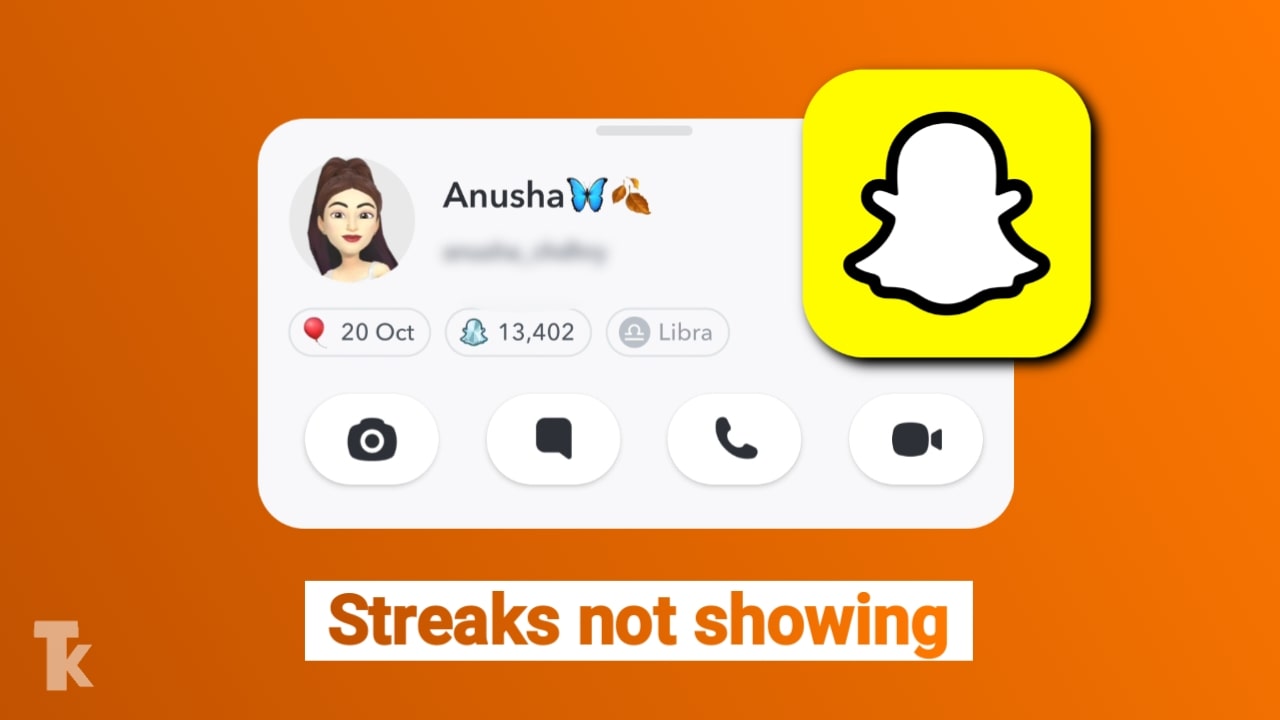Community engagement strategies transform passive stakeholders into active partners by leveraging frameworks like the IAP2 Spectrum and stakeholder mapping. Effective engagement bridges the digital divide through a mix of asynchronous engagement via civic tech tools and traditional methods like deliberative polling, ensuring organizations succeed in closing the feedback loop to build lasting trust.
Did you know that projects with real local input are twice as likely to gain long-term support? This guide shows how to align your work with the people you serve so both sides win.
We focus on clear steps you can use right away. You’ll learn how trust grows from steady feedback and honest information, not one-off initiatives.
Our approach sets simple expectations for communication and participation. That makes it easier to involve members and groups without adding extra complexity.
Expect practical tips for handling common issues that slow progress. We tie those tips to everyday realities, from responding to emerging issues to documenting outcomes that help your team learn and adapt.
Key Takeaways
- Clear communication and defined roles lead to better decisions and shared outcomes.
- Consistent feedback builds trust and stronger relationships over time.
- Simple, documented processes keep participation focused and effective.
- Address common issues early with a practical, repeatable approach.
- Aligning people and goals reduces friction and improves long-term results.
What Is Community Engagement? Definitions, Scope, and Core Principles
When people and policymakers share power, projects reflect real needs.
Community engagement is a strategic process focused on relationships, two-way communication, and mutual decision-making. It directly involves the residents who are affected by local issues and policy choices.
This approach sits within broader stakeholder engagement and overlaps with public participation. The difference is emphasis: it elevates lived experience and local knowledge in decisions.
From stakeholder engagement to public participation: how the concepts intersect
Use stakeholder work when you map interests and risks. Choose public participation for formal decision moments. Pick a mixed way when you need both outreach and shared authority.
Democratic foundations: lived experience, mutual decision-making, and transparency
Core principles
- Center lived experience to inform policy and development.
- Design a clear process that sets expectations for level of involvement.
- Value transparency so members trust how decisions are made.
| Method | When to use | Outcome |
|---|---|---|
| Face-to-face meetings | Local disputes, complex issues | Deeper relationships, rich feedback |
| Digital panels | Broad reach, ongoing updates | Faster input, wider participation |
| Hybrid approach | Large projects, policy development | Balanced access, informed decisions |
Why Community Engagement Matters for Better Outcomes and Trust
When people with local knowledge shape plans, projects make wiser choices and face fewer surprises.
Community engagement gathers a wider set of perspectives so you can make better decisions. That blend of lived experience and technical input reduces blind spots.
Transparency builds trust. When you share clear information, many organizations see lower resistance and a stronger social license to operate. Trust also makes it easier to explain choices later.
Early outreach saves time and resources. Spotting risks up front cuts rework and prevents costly delays. Over time, steady interaction lowers risk and boosts credibility.
Consistent communication leads to accountable practice. When voices are tracked and responses recorded, decisions are easier to justify and services align with priorities.
| Benefit | Why it matters | What you can do |
|---|---|---|
| Better decisions | More local insight reduces blind spots | Hold targeted listening sessions |
| Higher trust | Open info lowers opposition | Publish clear timelines and updates |
| Fewer delays | Early risk spotting saves resources | Map issues and act fast |
| Stronger relationships | Long-term contact builds credibility | Invest in ongoing touchpoints |
Types and Levels of Engagement: From Inform to Empower

Choosing the right format makes it easier to hear real needs and act on them. We outline in-person and digital methods, then map how deep your process should go.
Traditional, face-to-face participation
In-person meetings, deliberative polling, and citizens’ juries let members speak directly. These formats work best for sensitive issues and complex decisions.
When to use: local disputes, detailed deliberation, or when you need richer relationships.
Digital-first engagement
Online panels, participatory forums, and digital storytelling expand reach. This supports asynchronous engagement, allowing participation at any time which lowers barriers and collects diverse inputs across time zones.
Tip: Combine short online surveys with periodic forums to keep momentum without overloading participants.
Levels of depth: inform, consult, collaborate, empower
Map a clear level for each initiative using the IAP2 Spectrum framework. Inform shares facts. Consult asks for views. Collaborate shares decision-making. Empower hands authority to communities.
- Match level to available resources and the decisions at stake.
- Blend meetings and forums to avoid duplication and confusion.
- Document who decides what, and how input will influence outcomes.
Community Engagement Strategy: Planning, Processes, and Long-Term Vision
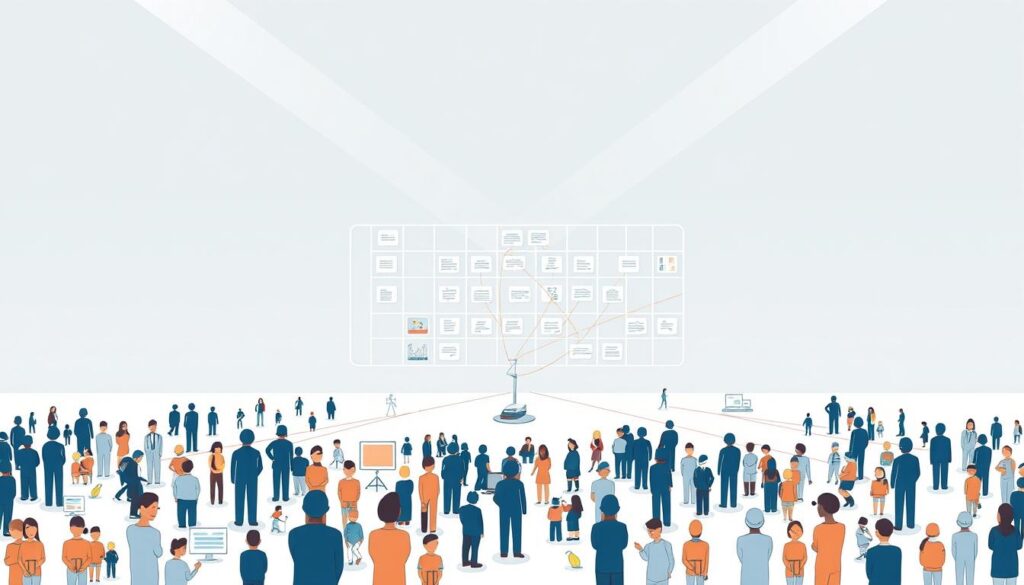
A clear plan links who matters to what you want to achieve and how you will get there.
Start by identifying stakeholders and grouping them by interest, influence, and potential impact. This makes outreach efficient and focused. Use simple mapping to show relationships and priorities.
Stakeholder analysis, segmentation, and mapping relationships
Map interests and power. Use stakeholder mapping to list groups, note their needs, and score influence vs. impact. Prioritize those who can help or hinder key outcomes.
- Segment members by role and needs.
- Map links between groups and decision makers.
- Rank outreach by influence and likely contribution.
Setting outcomes, aligning resources, and institutionalizing practice
Define measurable outcomes tied to residents’ needs and your organization’s goals. Clear targets keep initiatives actionable and assessable.
Align staff, budget, and tools to the process so plans are realistic. Embed routines, roles, and simple documentation so work continues through staff changes.
| Priority | Action | Measure |
|---|---|---|
| High | Targeted listening sessions | Number of representative inputs |
| Medium | Follow-up surveys | Response rate |
| Low | Informational updates | Open/read metrics |
We recommend a repeatable cycle: analyze, plan, act, and record outcomes. That habit tracks relationship health and feeds future decisions.
For practical guidance, review our primer on community engagement 101. It helps tie short-term actions to a longer development vision.
Two-Way Communication That Drives Participation and Feedback

When people can reach a real human quickly, participation rises and trust follows.
Choose channels your audience already uses. Use social media, email, phone, live chat, and local touchpoints like libraries, schools, and markets. That lowers effort for members and increases responses.
Channels that work: social, phone, email, live chat, and local spots
Staff each channel so people connect with a real person who listens, records the issue, and follows up. Quick, polite replies build trust and show you value time.
Pair online forums for broad input with meetings for deeper discussion. Forums gather many views; meetings let you explore solutions with small groups.
Closing the feedback loop: show how voices shape decisions
Successfully closing the feedback loop requires thanking contributors, summarizing themes, and publishing plain-language updates that link input to decisions. Make it clear which suggestions influenced outcomes and which could not be adopted.
“We heard you. Here is what changed and why.”
- Tag topics and summarize themes to turn casual questions into structured insights.
- Set service standards for response times and decision timelines.
- Phrase invites and reminders so they feel welcoming and respectful.
Results: better feedback, stronger relationships, and clearer decisions that reflect what people said.
Building Relationships and Trust With Community Members

Trust grows when your team shows up consistently, not only at big moments but in everyday spaces. Be present in local places and online. That steady presence helps residents see your group as reliable.
Practice small habits. Return calls promptly. Explain limits honestly. Say thank you for input.
Track relationships so your team remembers past conversations and preferences. A simple record avoids asking the same questions twice.
- Show up regularly in local spots and virtual channels.
- Log context, past decisions, and follow-ups for each member.
- Send plain-language updates, even when there is no fixed progress.
- Offer roles that match interests and time, so people can deepen participation without pressure.
Healthy relationships bridge differences and make it easier to co-create solutions when services or plans need to change. Over time, these ties help organizations and communities work toward shared decisions and better outcomes.
Inclusion and Equity: Reaching Marginalized Groups and Diverse Voices
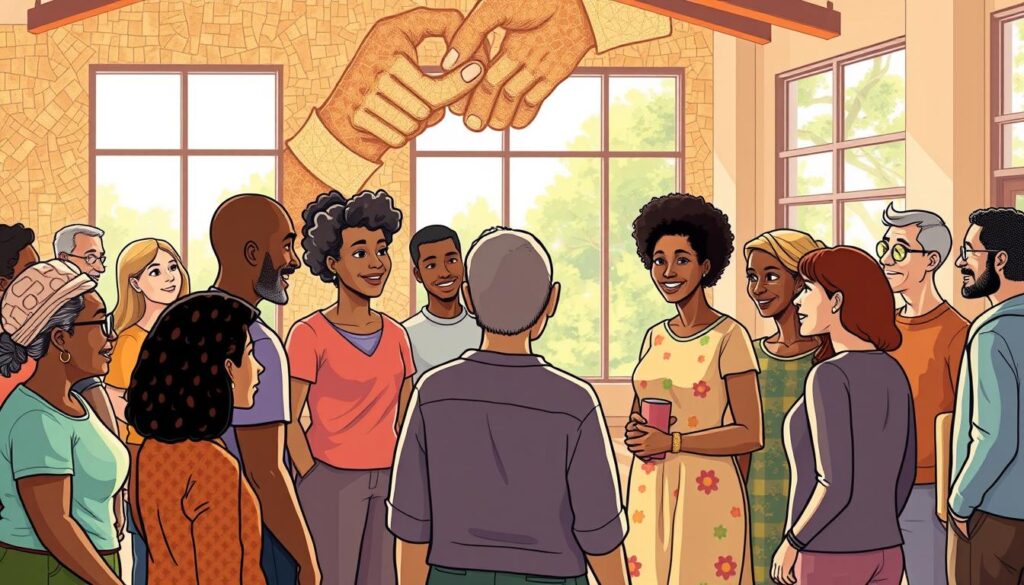
A good start is to find who is missing from the table and meet them where they already are. That means planning beyond online posts and public meetings. You build trust by going to trusted local spots and offering multiple ways to join.
Addressing power dynamics so every resident is heard
Power imbalances silence people when only leaders are asked. Use varied formats—small groups, one-on-one conversations, and anonymous surveys—to make space for quieter voices.
Make participation realistic: use plain language, provide translation, offer child care, and set flexible meeting times. Fund these supports so efforts are not ad hoc but sustained.
Balancing digital access with in-person opportunities
Digital tools expand reach, but they do not replace in-person options. Bridging the digital divide ensures that those without reliable internet are not excluded. Balance online surveys and forums with local drop-ins, library sessions, and door-to-door outreach for those with limited connectivity.
- Partner with trusted local organizations to share resources and reduce barriers.
- Track who participates so your communication and services adapt as needs change.
- Use simple records to spot gaps and plan targeted outreach.
For practical tips on using social channels alongside in-person work, see our guide on social media and outreach. When you pair intentional methods with steady funding, more voices shape better decisions.
Measuring Engagement: Data, Indicators, and Evidence for Action
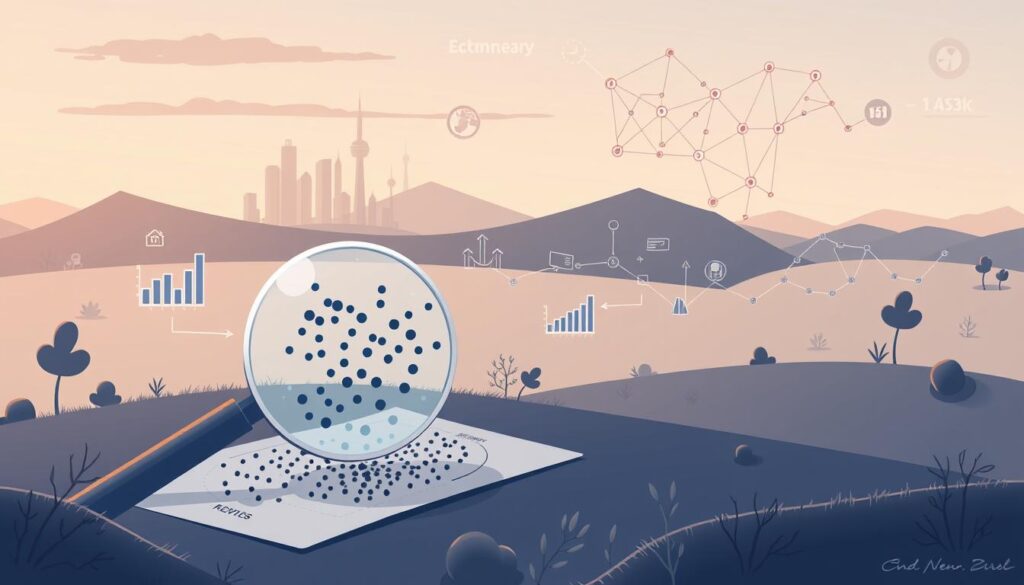
Collecting the right data makes it easier to show who was heard and what changed.
Routine, standardized collection keeps your work honest and useful. Use short tools that capture opinions, perceptions, and needs. Track who took part and whether samples reflect local demographics.
Routine collection, representativeness, and transparent reporting
Make indicators simple. Measure reach, representativeness, response time, and top feedback themes. Report results in plain language so members and organizations can understand progress.
Linking participation to services and policy
Map inputs to outcomes. Note what service changed, which policy adjusted, and the timeline. Close the loop with timely updates so people see impact.
| Indicator | What it shows | Action |
|---|---|---|
| Reach | Who we contacted | Adjust channels and timing |
| Representativeness | Sample vs. population | Target outreach to under‑served groups |
| Response time | Speed of replies | Set service standards |
| Feedback themes | Common needs and concerns | Prioritize service fixes |
“Data that is clear and shared builds trust and makes better decisions possible.”
- Set a regular cadence that fits your resources.
- Protect privacy while publishing useful information.
- Use findings to improve processes and strengthen relationships.
Common Challenges in Community Engagement and How to Avoid Tokenism

Sustaining meaningful participation requires durable roles, modest budgets, and routine practice. Too often, work depends on short grants and rotating staff. That leads to stop-start processes and frustrated residents.
Funding, staffing, and sustaining processes beyond projects
Limited funding and thin staffing are the top challenges. When teams lack time, interactions shrink to one-off events.
Make it practical: set a small baseline budget for ongoing touchpoints. Assign clear roles so someone always cares for follow-ups. Use simple records to avoid repeating questions to the same people.
Preventing “tick-box” exercises: expectations, feedback, and accountability
Token involvement breaks trust. You can avoid it by stating what can change, what is fixed, and when people will hear back.
- Publish a short timeline that shows when feedback will be reviewed.
- Summarize what you heard and what changed, even if only minor edits were made.
- Streamline internal approvals so responses reach members faster.
“We will tell you what changed and why — and who made the call.”
Result: clearer expectations, stronger trust, and fewer wasted meetings. With small investments in staff time and simple processes, programs move from tokenism to meaningful practice.
Community Engagement in Practice: Government, Development, and Local Initiatives
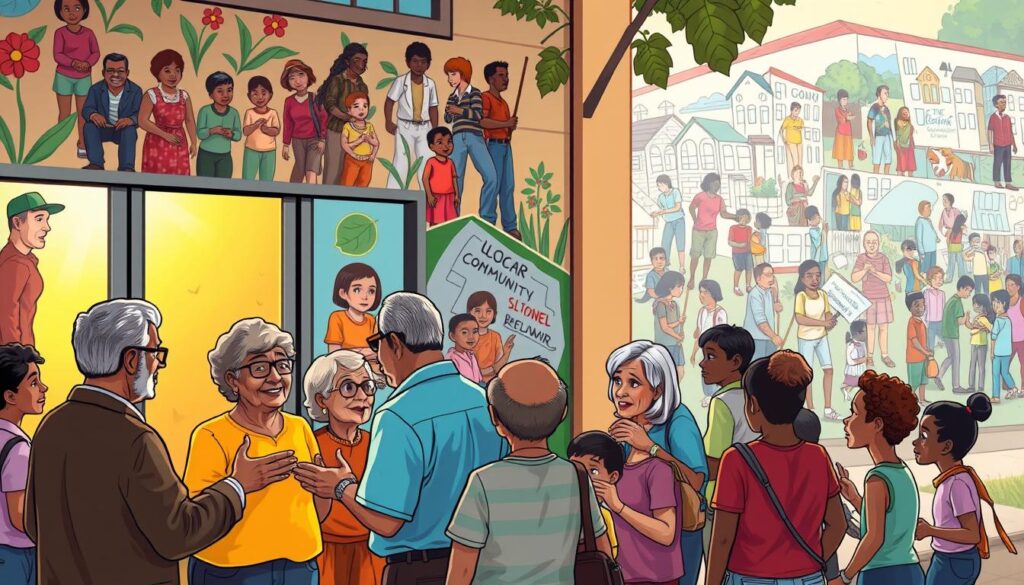
Practical examples show how structured outreach turns complex choices into fairer, faster results.
Government use cases in the United States
The U.S. Department of Energy organizes panels of independent experts using stakeholder software. Teams group reviewers by expertise, location, and DEI traits to match grants to programs.
Why it works: structured selection reduces bias and speeds decisions. It also documents who reviewed what, which strengthens public participation records.
Sustainable development projects
Early participation in projects like wind farms or desalination shapes siting, benefit-sharing, and mitigation measures.
Result: fewer protests, clearer permits, and better long-term outcomes because communities had input on key trade-offs.
Libraries and local initiatives
Rural libraries host farmers’ markets, seed libraries, and community gardens. These programs grow skills, networks, and library use.
They create low-barrier touchpoints where members learn, volunteer, and build trust with local groups.
How to translate examples into action
- Map expertise and interests before convening meetings and forums.
- Use simple software to group reviewers and record decisions.
- Start participation early to shape design and reduce conflict.
- Pair local touchpoints (libraries, markets) with formal forums to widen reach.
“When sectors work together, collaboration produces visible benefits and stronger relationships.”
Community Engagement Tools, Resources, and Collaboration Frameworks

Find systems that blend simple databases, messaging, and reporting so your work scales cleanly. Good tools record contacts, track interaction history, and let you segment lists by need or interest.
Selecting software, frameworks, and partnerships
Match tools to your process so invites, feedback capture, and follow-ups are consistent. That reduces manual work and improves response rates. Select civic tech tools that integrate seamlessly with your existing workflow.
- Look for: stakeholder databases, interaction histories, automated messaging, segmentation, and clear reporting.
- Pair tools with workflow: define who invites members, who logs feedback, and who closes the loop.
- Use collaboration frameworks to set shared goals, roles, and timelines with partner organizations.
- Light governance: name message approvers, set reply standards, and schedule review points.
- Resource checklist: budget for licenses, assign training time, and plan simple admin roles.
Tip: start small, test a single pilot, then scale tools across engagement initiatives so processes stay reliable as you grow.
Conclusion
Sustained routines make it easier to turn input into better services and clearer policy. Use simple steps so your team can log feedback, run short meetings, and report results to residents. That steady approach builds knowledge and keeps public participation real, not token.
Start small, measure what matters. Track participation, note who responds, and adjust resources so initiatives stay practical. Share plain summaries that show how suggestions influenced policy and services.
With this approach to community engagement, organizations and government projects can foster transparency, strengthen collaboration, and embed participation as everyday practice. Keep learning, adapt your strategy, and make the process part of routine work.
FAQ
What does "effective community engagement" mean and why should I care?
Effective community engagement means creating ongoing, two-way relationships that inform decisions and build trust. It helps you design better services, reduce conflict, and gain social license for projects. By listening, responding, and showing results, you improve outcomes and strengthen local support.
How do stakeholder engagement, public participation, and community outreach differ?
Stakeholder engagement targets groups with a direct interest, public participation invites wide input on decisions, and outreach raises awareness and invites involvement. All overlap: you can start with outreach, use participation for decision points, and maintain stakeholder relationships for ongoing input.
What core principles should guide my approach?
Ground work in transparency, respect for lived experience, shared decision-making, and accountability. Set clear goals, explain limits, and keep feedback loops visible so people see how their input shapes outcomes.
How do better engagement practices improve trust and outcomes?
When people feel heard and see their input reflected in policy or services, trust rises. That reduces opposition, speeds approvals, and yields more equitable, practical solutions that match real needs.
What are the main types and levels of participation I can use?
Use a spectrum: inform (share information), consult (ask opinions), collaborate (work with groups), and empower (delegate decisions). Tactics include town meetings, citizen juries, online forums, and participatory budgeting depending on depth and context.
Should I run face-to-face events or digital engagement?
Both. Face-to-face formats like assemblies build deep relationships and trust. Digital channels scale reach and convenience. Mix methods to include people with different needs and access levels.
How do I plan a long-term engagement strategy?
Start with stakeholder analysis and mapping. Set measurable outcomes, align resources, assign roles, and institutionalize processes so engagement continues beyond single projects. Include training and clear governance.
What channels work best for two-way communication?
Combine social media, email, phone, live chat, and local touchpoints like libraries or community centers. Choose channels that match your audience and capacity, then commit to timely, respectful responses.
How do I close the feedback loop so people know their input mattered?
Share summaries, explain decisions, and show specific changes made because of input. Use newsletters, public reports, and follow-up meetings to keep participants informed and engaged.
How can I build trust with residents and groups?
Be consistent, transparent, and accountable. Show up in person, honor commitments, and create safe spaces for honest dialogue. Trust grows when people see real results and fair processes.
How do I reach marginalized or hard-to-reach populations?
Address power dynamics, remove barriers, and meet people where they are. Offer accessible meeting times, language support, childcare, transportation, and both digital and in-person options to widen participation.
How should I balance online engagement with in-person opportunities?
Use digital tools for broad outreach and convenience, and keep in-person options for deeper deliberation and relationship building. Ensure both channels provide equivalent access to information and decision-making.
What indicators show engagement is working?
Track participation rates, demographic representativeness, quality of feedback, and whether input leads to policy or service changes. Combine quantitative metrics with qualitative stories and transparent reporting.
How can I link participation to concrete outcomes?
Define desired outcomes early, map how input informs choices, and report back on changes. Use pilot projects and evaluations to demonstrate impact and refine practice.
What common challenges cause engagement to fail?
Limited funding, poor staffing, short timelines, and unclear goals undermine efforts. Tokenistic approaches that ignore feedback or lack follow-through erode trust fast.
How do I avoid "tick-box" participation and tokenism?
Set meaningful roles for participants, allocate resources for follow-up, and commit to accountability. Be honest about limits and provide evidence of how voices influenced decisions.
How do governments in the United States use public participation?
Local, state, and federal agencies run consultations, hearings, and advisory groups for planning, zoning, and policy development. Early, consistent engagement improves legal compliance and public support.
How does early participation help development and sustainability projects?
Involving people early identifies local needs, reduces delays, and increases buy-in. For sustainable development, early input aligns projects with environmental and social priorities.
What role can libraries and local nonprofits play?
Libraries and nonprofits act as trusted intermediaries, host events, provide digital access, and co-design initiatives with residents. They help broaden reach and deepen local partnerships.
What tools and frameworks support scalable engagement?
Use software like Bang the Table, CitizenLab, or NationBuilder alongside collaborative frameworks like participatory budgeting and design thinking. Choose tools that fit your goals, budget, and privacy standards.
How do I select the right software or partner for my work?
Assess needs, audience, accessibility, security, and reporting capabilities. Pilot options, ask for references, and prioritize tools that enhance two-way dialogue rather than simply collecting comments.



